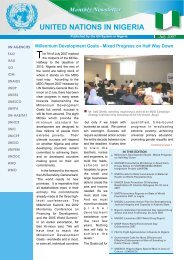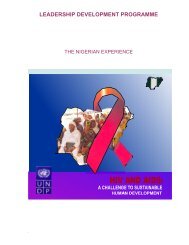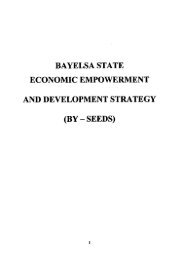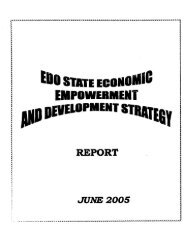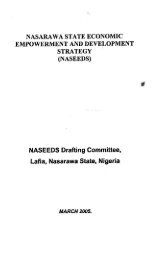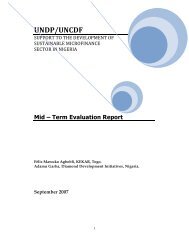Niger Delta Human Development Report - UNDP Nigeria - United ...
Niger Delta Human Development Report - UNDP Nigeria - United ...
Niger Delta Human Development Report - UNDP Nigeria - United ...
You also want an ePaper? Increase the reach of your titles
YUMPU automatically turns print PDFs into web optimized ePapers that Google loves.
The youth crisis began with the Twelve Day<br />
Revolution led by Isaac Boro. On 23<br />
February 1966, a group of young Ijaw men<br />
declared the Ijaw territory of the <strong>Niger</strong><br />
<strong>Delta</strong> ‘The <strong>Niger</strong> <strong>Delta</strong> People’s Republic’.<br />
Their aim was to liberate the region and<br />
obtain access to the benefits from its<br />
petroleum resources. The group blew up<br />
pipelines, particularly those linking Oloibiri<br />
and Ughelli to Port Harcourt. Within 12<br />
days, Boro and his associates were arrested,<br />
tried and sentenced to death, but<br />
subsequently pardoned.<br />
There was no widespread youth crisis in<br />
the region until the 1990s, when the Ogoni<br />
and others revolted. Several localized<br />
conflicts flared, however, characterized<br />
Box 5.5: The Bayelsa Governor’s Viewpoint on the Youth Crisis<br />
mainly by protests against oil companies.<br />
The most noteworthy was in the<br />
Umuechem community in Rivers State. In<br />
December 1990, youths demonstrated<br />
against Shell to express their displeasure<br />
over the environmental impact of oil<br />
exploitation and the lack of development<br />
in the area. The police, invited by Shell,<br />
quelled the demonstration. After a police<br />
officer was reported missing, and youths<br />
were suspected of killing him during the<br />
demonstration, the police sent a punitive<br />
mission to the community. There was<br />
extensive loss of lives and property.<br />
In 1990, the educated elite formed the<br />
Movement for the Survival of the Ogoni<br />
More than any other area in <strong>Niger</strong>ia, the <strong>Niger</strong> <strong>Delta</strong>, where oil and gas exploration companies operate, has engaged the attention of those<br />
interested in <strong>Niger</strong>ia and its survival. In recent times, conference after conference, report after report and commission after commission, have<br />
attempted to tender solutions to what has been described as the <strong>Niger</strong> <strong>Delta</strong> crises. Yet the social conflicts are not abating. The principal<br />
actors in these conflicts have been the youths, leading to what has now come to be known as youth restiveness. Strictly speaking, I have no<br />
problems with the phenomenon of youth restiveness. Given the prevailing socioeconomic condition in the <strong>Niger</strong> <strong>Delta</strong>, the youths have no<br />
choice but to be restive. The only problem is that sometimes, they have overstepped their bounds and adopted methods which have led to<br />
violence and lawlessness. Otherwise, their goals have been noble, geared as they are toward protecting their future from complete ruin.<br />
Source: A lecture delivered by Governor D.P.C. Alamieyeseigha on 7 April 2005 at the Lagos Country Club.<br />
Box 5.6: Women’s Protest in Warri against the Shell Petroleum <strong>Development</strong> Company<br />
In August, a large group of women barricaded the gate of SPDC’s office in Warri. Unlike other similar demonstrations in the area, it did<br />
not concern requests for employment or community development projects. Instead, it was rooted in a contractual dispute.<br />
SPDC employs drivers through logistics contractors, who supply vehicles and drivers to transport staff on company business. There was a<br />
contractual dispute between the drivers and their employers—and the drivers decided to blockade the SPDC gates to press for a resolution.<br />
Subsequently, staff at the gates noticed that the drivers had mobilized a large group of women to participate in and support their<br />
demonstration.<br />
The police were called as the demonstrators were refusing to allow passage through the gates. The crowd was subsequently dispersed, but<br />
accounts vary as to the manner in which this was done. A number of the women present at the demonstration claimed that the police used<br />
excessive force and local newspapers reported that one woman had been shot and 15 other women were missing.<br />
Alerted by these articles, a 20-women delegation from the National Council of Women’s Societies decided to visit Warri to establish the<br />
truth of what took place. They found no evidence to support the story about women being shot or missing. However, they did find that ten<br />
women had minor bruises and cuts.<br />
Eight women were treated at the SPDC clinic in Warri following the demonstration. All had minor injuries and none required hospitalization.<br />
Four of the women treated said that they had been beaten. In only one case was there any indication that this might have been so, but the<br />
medical evidence was by no means conclusive.<br />
Source: Shell Petroleum <strong>Development</strong> Company Annual <strong>Report</strong> 2002.<br />
126 NIGER DELTA HUMAN DEVELOPMENT REPORT



